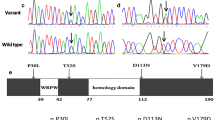Abstract
Congenital heart defect (CHD) is one of the most common birth defects in China, while pulmonary atresia with intact ventricular septum (PA–IVS) is the life-threatening form of CHD. Numerous previous studies revealed that rare copy number variants (CNVs) play important roles in CHD, but little is known about the prevalence and role of rare CNVs in PA–IVS. In this study, we conducted a genome-wide scanning of rare CNVs in an unselected cohort consisted of 54 Chinese patients with PA–IVS and 20 patients with pulmonary atresia with ventricular septal defect (PA–VSD). CNVs were identified in 6/20 PA–VSD patients (30%), and three of these CNVs (15%) were considered potentially pathogenic. Two pathogenic CNVs occurred at a known CHD locus (22q11.2) and one likely pathogenic deletion located at 13q12.12. However, no rare CNVs were detected in patients with PA–IVS. Potentially pathogenic CNVs were more enriched in PA–VSD patients than in PA–IVS patients (p = 0.018). No rare CNVs were detected in patients with PA–IVS in our study. PA/IVS might be different from PA/VSD in terms of genetics as well as anatomy.

Similar content being viewed by others
References
Silvey M, Brandao LR (2017) Risk factors, prophylaxis, and treatment of venous thromboembolism in congenital heart disease patients. Front Pediatr 5:146. https://doi.org/10.3389/fped.2017.00146
van der Linde D, Konings EE, Slager MA, Witsenburg M, Helbing WA, Takkenberg JJ, Roos-Hesselink JW (2011) Birth prevalence of congenital heart disease worldwide: a systematic review and meta-analysis. J Am Coll Cardiol 58(21):2241–2247. https://doi.org/10.1016/j.jacc.2011.08.025
Abid D, Elloumi A, Abid L, Mallek S, Aloulou H, Chabchoub I, Bouraoui A, Thabet A, Gargouri L, Zribi M, Yaich S, Hachicha M, Gargouri A, Mahfoudh A, Maatoug S, Dammak J, Kammoun S (2014) Congenital heart disease in 37,294 births in Tunisia: birth prevalence and mortality rate. Cardiol Young 24(5):866–871. https://doi.org/10.1017/S1047951113001194
Gao M, He X, Zheng J (2017) Advances in molecular genetics for pulmonary atresia. Cardiol Young 27(2):207–216. https://doi.org/10.1017/S1047951116001487
Mohan S, Weinberg PM, Glatz AC (2016) Pulmonary atresia with intact ventricular septum and coronary cameral fistulae: an unusual finding of a subsystemic right ventricle. Cardiol Young 26(5):979–982. https://doi.org/10.1017/S1047951115002711
Xie L, Chen JL, Zhang WZ, Wang SZ, Zhao TL, Huang C, Wang J, Yang JF, Yang YF, Tan ZP (2014) Rare de novo copy number variants in patients with congenital pulmonary atresia. PLoS ONE 9(5):e96471. https://doi.org/10.1371/journal.pone.0096471
Zampi JD, Hirsch-Romano JC, Goldstein BH, Shaya JA, Armstrong AK (2014) Hybrid approach for pulmonary atresia with intact ventricular septum: early single center results and comparison to the standard surgical approach. Catheter Cardiovasc Interv 83(5):753–761. https://doi.org/10.1002/ccd.25181
Fesslova V, Brankovic J, Lalatta F, Villa L, Meli V, Piazza L, Ricci C (2011) Recurrence of congenital heart disease in cases with familial risk screened prenatally by echocardiography. J Pregnancy 2011:368067. https://doi.org/10.1155/2011/368067
Digilio MC, Marino B (2016) What is new in genetics of congenital heart defects? Front Pediatr 4:120. https://doi.org/10.3389/fped.2016.00120
Cowan JR, Tariq M, Shaw C, Rao M, Belmont JW, Lalani SR, Smolarek TA, Ware SM (2016) Copy number variation as a genetic basis for heterotaxy and heterotaxy-spectrum congenital heart defects. Philos Trans R Soc Lond B. https://doi.org/10.1098/rstb.2015.0406
Edwards JJ, Gelb BD (2016) Genetics of congenital heart disease. Curr Opin Cardiol 31(3):235–241. https://doi.org/10.1097/HCO.0000000000000274
Gelb BD (2013) Recent advances in understanding the genetics of congenital heart defects. Curr Opin Pediatr 25(5):561–566. https://doi.org/10.1097/MOP.0b013e3283648826
Soemedi R, Topf A, Wilson IJ, Darlay R, Rahman T, Glen E, Hall D, Huang N, Bentham J, Bhattacharya S, Cosgrove C, Brook JD, Granados-Riveron J, Setchfield K, Bu’lock F, Thornborough C, Devriendt K, Breckpot J, Hofbeck M, Lathrop M, Rauch A, Blue GM, Winlaw DS, Hurles M, Santibanez-Koref M, Cordell HJ, Goodship JA, Keavney BD (2012) Phenotype-specific effect of chromosome 1q21.1 rearrangements and GJA5 duplications in 2436 congenital heart disease patients and 6760 controls. Hum Mol Genet 21(7):1513–1520. https://doi.org/10.1093/hmg/ddr589
Miller DT, Shen Y, Wu BL (2012) Oligonucleotide microarrays for clinical diagnosis of copy number variation and zygosity status. Curr Protoc Hum Genet. https://doi.org/10.1002/0471142905.hg0812s74
Geng J, Picker J, Zheng Z, Zhang X, Wang J, Hisama F, Brown DW, Mullen MP, Harris D, Stoler J, Seman A, Miller DT, Fu Q, Roberts AE, Shen Y (2014) Chromosome microarray testing for patients with congenital heart defects reveals novel disease causing loci and high diagnostic yield. BMC Genom 15:1127. https://doi.org/10.1186/1471-2164-15-1127
Kearney HM, Thorland EC, Brown KK, Quintero-Rivera F, South ST, Working Group of the American College of Medical Genetics Laboratory Quality Assurance Committee (2011) American College of Medical Genetics standards and guidelines for interpretation and reporting of postnatal constitutional copy number variants. Genet Med 13(7):680–685. https://doi.org/10.1097/GIM.0b013e3182217a3a
Jansen FA, Blumenfeld YJ, Fisher A, Cobben JM, Odibo AO, Borrell A, Haak MC (2015) Array comparative genomic hybridization and fetal congenital heart defects: a systematic review and meta-analysis. Ultrasound Obstet Gynecol 45(1):27–35. https://doi.org/10.1002/uog.14695
Momma K (2010) Cardiovascular anomalies associated with chromosome 22q11.2 deletion syndrome. Am J Cardiol 105(11):1617–1624. https://doi.org/10.1016/j.amjcard.2010.01.333
Warburton D, Ronemus M, Kline J, Jobanputra V, Williams I, Anyane-Yeboa K, Chung W, Yu L, Wong N, Awad D, Yu CY, Leotta A, Kendall J, Yamrom B, Lee YH, Wigler M, Levy D (2014) The contribution of de novo and rare inherited copy number changes to congenital heart disease in an unselected sample of children with conotruncal defects or hypoplastic left heart disease. Hum Genet 133(1):11–27. https://doi.org/10.1007/s00439-013-1353-9
Xu YJ, Wang J, Xu R, Zhao PJ, Wang XK, Sun HJ, Bao LM, Shen J, Fu QH, Li F, Sun K (2011) Detecting 22q11.2 deletion in Chinese children with conotruncal heart defects and single nucleotide polymorphisms in the haploid TBX1 locus. BMC Med Genet 12:169. https://doi.org/10.1186/1471-2350-12-169
Mahle WT, Crisalli J, Coleman K, Campbell RM, Tam VKH, Vincent RN, Kanter KR (2003) Deletion of chromosome 22q11.2 and outcome in patients with pulmonary atresia and ventricular septal defect. Ann Thorac Surg 76(2):567–571. https://doi.org/10.1016/s0003-4975(03)00516-2
van Engelen K, Topf A, Keavney BD, Goodship JA, van der Velde ET, Baars MJH, Snijder S, Moorman AF, Postma AV, Mulder BJM (2010) 22q11.2 deletion syndrome is under-recognised in adult patients with tetralogy of Fallot and pulmonary atresia. Heart 96(8):621–624. https://doi.org/10.1136/hrt.2009.182642
Zhang X, Xu Y, Liu D, Geng J, Chen S, Jiang Z, Fu Q, Sun K (2015) A modified multiplex ligation-dependent probe amplification method for the detection of 22q11.2 copy number variations in patients with congenital heart disease. BMC Genom 16:364. https://doi.org/10.1186/s12864-015-1590-5
Manning M, Hudgins L, Professional P, Guidelines C (2010) Array-based technology and recommendations for utilization in medical genetics practice for detection of chromosomal abnormalities. Genet Med 12(11):742–745. https://doi.org/10.1097/GIM.0b013e3181f8baad
Bentham J, Bhattacharya S (2008) Genetic mechanisms controlling cardiovascular development. Ann N Y Acad Sci 1123:10–19. https://doi.org/10.1196/annals.1420.003
Izumi K, Lippa AM, Wilkens A, Feret HA, McDonald-McGinn DM, Zackai EH (2013) Congenital heart defects in oculodentodigital dysplasia: report of two cases. Am J Med Genet A 161A(12):3150–3154. https://doi.org/10.1002/ajmg.a.36159
Sun X, Meng Y, You T, Li P, Wu H, Yu M, Xie X (2013) Association of growth/differentiation factor 1 gene polymorphisms with the risk of congenital heart disease in the Chinese Han population. Mol Biol Rep 40(2):1291–1299. https://doi.org/10.1007/s11033-012-2172-0
Gelb BD, Chung WK (2014) Complex genetics and the etiology of human congenital heart disease. Cold Spring Harbor Perspect Med 4(7):a013953. https://doi.org/10.1101/cshperspect.a013953
Wang W, Hou Z, Wang C, Wei C, Li Y, Jiang L (2013) Association between 5, 10-methylenetetrahydrofolate reductase (MTHFR) polymorphisms and congenital heart disease: a meta-analysis. Meta Gene 1:109–125. https://doi.org/10.1016/j.mgene.2013.09.009
Sayin Kocakap BD, Sanli C, Cabuk F, Koc M, Kutsal A (2015) Association of MTHFR A1298C polymorphism with conotruncal heart disease. Cardiol Young 25(7):1326–1331. https://doi.org/10.1017/S1047951114002467
Phan HC, Taylor JL, Hannon H, Howell R (2015) Newborn screening for spinal muscular atrophy: anticipating an imminent need. Semin Perinatol 39(3):217–229. https://doi.org/10.1053/j.semperi.2015.03.006
Acknowledgements
We thank all the patients for their participating in this study.
Funding
The study was supported by the National Key R&D Program of China (Grant No. 2017YFC1308100), the National Natural Science Foundation of China (Grant Number 81501604 and 81771977), the Biomedical Engineering Fund of Shanghai Jiao Tong University (Grant No. YG2015MS34), and the Science and Technology Development Fund of Pudong New Area (Grant No. PKJ2017-Y02).
Author information
Authors and Affiliations
Contributions
XMH and XQZ performed the experiments and drafted the manuscript. HJ, XYZ, and MCG collected the samples. JG and ZJZ performed the bioinformatics analyses. HWC and QHF helped with the analysis and writing of the manuscript. ZQZ and JHZ conceived of and supervised the overall research. All authors read, approved and contributed to the final manuscript.
Corresponding authors
Ethics declarations
Conflict of interest
The authors declare that they have no interest to disclose.
Ethical Approval
All procedures performed in studies involving human participants were in accordance with the ethical standards of the institutional and/or national research committee and with the 1964 Helsinki declaration and its later amendments or comparable ethical standards.
Informed Consent
Informed consent was obtained from all individual participants included in the study.
Additional information
Publisher’s Note
Springer Nature remains neutral with regard to jurisdictional claims in published maps and institutional affiliations.
Electronic supplementary material
Below is the link to the electronic supplementary material.
Rights and permissions
About this article
Cite this article
He, X., Zhang, X., Jing, H. et al. Rare Copy Number Variations Might Not be Involved in the Molecular Pathogenesis of PA–IVS in an Unselected Chinese Cohort. Pediatr Cardiol 40, 762–767 (2019). https://doi.org/10.1007/s00246-019-02062-x
Received:
Accepted:
Published:
Issue Date:
DOI: https://doi.org/10.1007/s00246-019-02062-x




